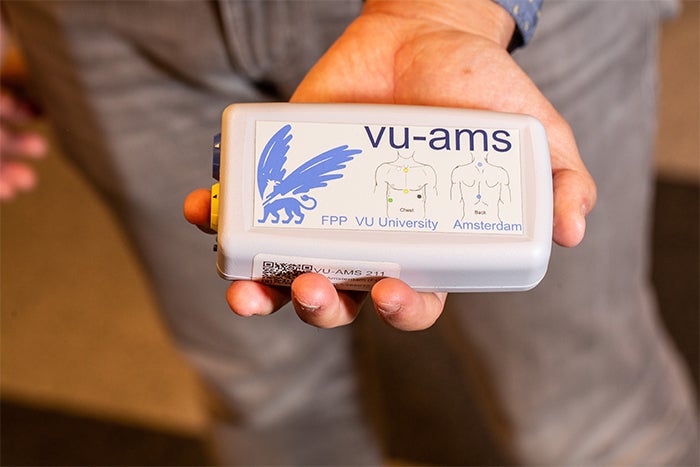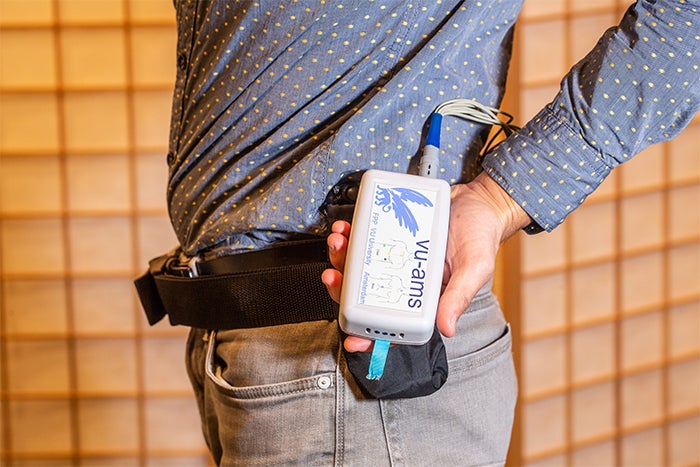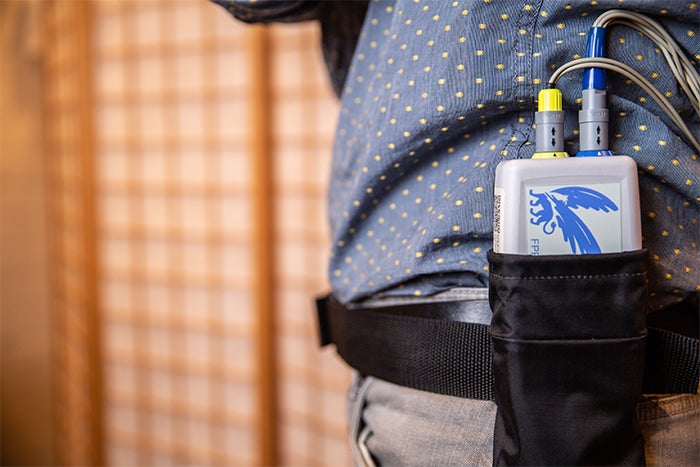Ambulatory Monitoring System
Designed for non-invasive continuous measurement of autonomic nervous systemAmbulatory Monitoring System VU-AMS 5fs
The VU-AMS is an ambulatory monitoring system designed for non-invasive continuous measurement of autonomic nervous system activity to assess exposure to stress in real life. It combines electrocardiogaphy (ECG), impedance cardiography (ICG), electrodermal activity (EDA) and triaxial accelerometry measurement into an easy to use, light-weight, battery-operated device.
Usability
The VU University Ambulatory Monitoring System (VU-AMS) is used world-wide by over 50 research groups to study the autonomic nervous system in a variety of naturalistic and experimental settings. It has been used to study the effects of acute mental and social stress, ADHD, aggression, anxiety and depressive disorders, poor attachment, circadian rhythms, exercise training, hyperventilation, migraine, sleep, sleep deprivation, sleep disorders, chronic work stress, repeated worrying, and in studies linking the autonomic nervous system to metabolic and immunological risk factors.
Due to its non-invasive character the VU-AMS can be applied to almost all subjects, including vulnerable groups like very young children (age < 1 year), pregnant women and subjects with an intellectual disability.
Features
- Ambulatory continuous monitoring, study the autonomic nervous system in a variety of naturalistic and experimental settings.
- Non-invasive, can be applied almost any group of interest, including vulnerable groups such as infants and pregnant women.
- Can record 24-48 hours on two AA alkaline batteries.
- Integrated software suite for quality control, data labeling, data reduction, and extraction of key variables.
- The current version of the VU-AMS can be used to measure the key variables:
- Heart Rate / Inter beat Interval (IBI)
- Heart Rate Variability (SDNN, RMSSD, IBI power spectrum: HF, LF)
- Respiratory Sinus Arrhythmia (RSA)
- Pre-Ejection Period (PEP)
- Left Ventricular Ejection Time (LVET)
- Respiration Rate (RR)
- Stroke Volume (SV) and Cardiac Output (CO)
- Skin Conductance Level (SCL) and Skin Conductance Responses (SCRs)
- Tri-Axial Accelerometry (Body Movement)




Specifications
- Dimensions L x W x H : 126 x 69 x 32 mm
- Weight with battery and leads : 260 gr
- Data memory : Compact flash up to 4GB
- Power : 2 AA Alkaline batteries / 2 AA Nickel-metal hydride batteries
- Communication : Infrared to USB
- Recording time : 24 to 48 hrs
- ECG: 11mVp-p, up to 1kHz
- ICG (ΔZ0): 1/-1 Ω, up to 1 kHz
- ICG (Z0): 0-36 Ω, up to 250 Hz
- SCL: 0-100 µS, up to 10Hz
- Motion: +3/-3g, up to 1 kHz
Credentials
The VU University Ambulatory Monitoring System (VU-AMS) developed at the VU University in Amsterdam is used worldwide by many research groups to study stress and emotion in both laboratory and naturalistic settings. A main network of scientific collaboration is maintained by prof. dr. Eco de Geus with a number of VU-AMS researchers in the Netherlands and abroad.
Read also the credential of Eco de Geus, head of the department of Biological Psychology and co-director of the Netherlands Twin Registry at the VU University about the success of The VU University Ambulatory Monitoring System.
References / related publications
o cite the VU-AMS system you could use the first two journal publications describing the VU-AMS 4.6 device:
E.J. De Geus, G.H. Willemsen, C.H. Klaver and L.J. Van Doornen (1995)
Ambulatory measurement of respiratory sinus arrhythmia and respiration rate
Biol.Psychol., 41(3):205--227
Willemsen, G. H. M., de Geus, E. J. C., Klaver, C. H. A. M., VanDoornen, L. J. P., & Carroll, D. (1996).
Ambulatory monitoring of the impedance cardiogram.
Psychophysiology, 33, 184-193.
Or you may specifically reference papers that provide validation for the VU-AMS assessment of heart rate variability (RSA), systolic time intervals (PEP)or stroke volume and cardiac output (SV, CO).
RSA:
A.D. Goedhart, van der Sluis S., J.H. Houtveen, G. Willemsen and E.J. De Geus (2007)
Comparison of time and frequency domain measures of RSA in ambulatory recordings
Psychophysiology, 44(2):203--21
PEP:
H. Riese, P.F. Groot, van den Berg M., N.H. Kupper, E.H. Magnee, E.J. Rohaan, T.G. Vrijkotte, G.
Willemsen and E.J. De Geus (2003)
Large-scale ensemble averaging of ambulatory impedance cardiograms.
Behav.Res.Methods Instrum.Comput., 35(3):467--477
van Lien R, Schutte NM, Meijer JH, de Geus EJ (2013).
Estimated preejection period (PEP) based on the detection of the R-wave and dZ/dt-min peaks does not adequately reflect the actual PEP across a wide range of laboratory and ambulatory conditions. Int J Psychophysiol. 87(1):60-9.
SV:
A.D. Goedhart, N. Kupper, G. Willemsen, D.I. Boomsma and E.J. De Geus (2006)
Temporal stability of ambulatory stroke volume and cardiac output measured by impedance cardiography
Biol.Psychol., 72(1):110--117
Nederend I, Ten Harkel ADJ, Blom NA, Berntson GG, de Geus EJC (2017).
Impedance cardiography in healthy children and children with congenital heart disease: Improving stroke volume assessment. Int J Psychophysiol. 120:136-147
More information
VU-AMS Development Team
E vu-ams@psy.vu.nl
